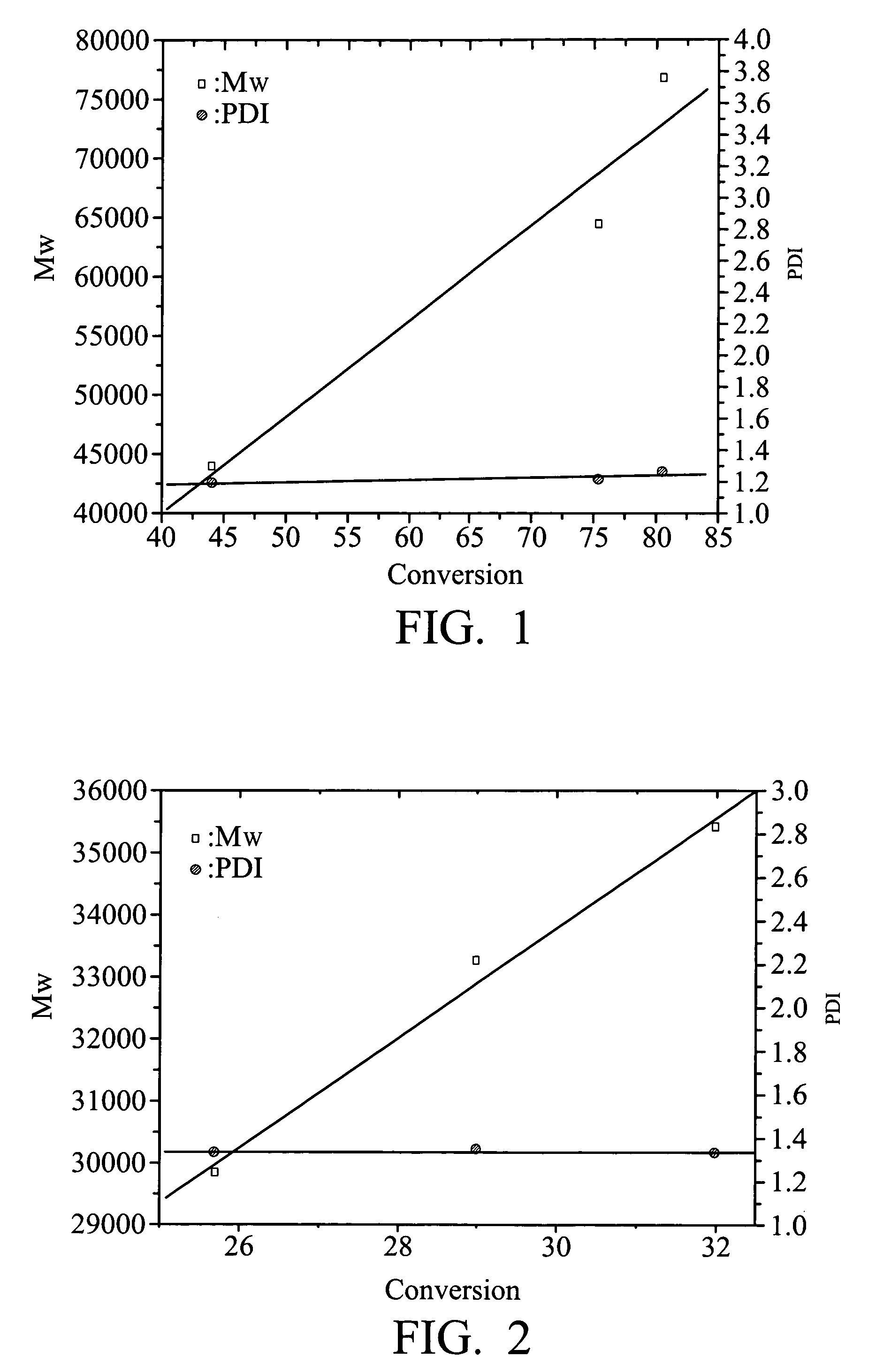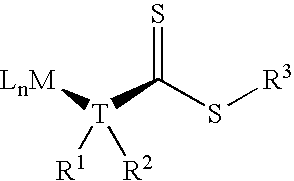Chain transfer reagent, free radical polymerization employing the same and resulting polymers
a chain transfer and free radical polymerization technology, applied in the field of reversible additionfragmentation chain transfer reagents, can solve the problems of limited variety of monomers applied to the above polymerization methods, limited ability to precisely modify the configuration of polymer products, and inefficient polymerization of some monomers, such as acrylate, to achieve the effect of narrowing the molecular weight distribution
- Summary
- Abstract
- Description
- Claims
- Application Information
AI Technical Summary
Benefits of technology
Problems solved by technology
Method used
Image
Examples
example 1
[0053]Organometallic RAFT reagents (1):
[0054]
[0055]In a nitrogen atmosphere, 0.65 g (1 mmol) of [W(CO)5P(C6H5)2C(═S)S]K, and 30 ml of dichloromethane were added to a round-bottom flask at room temperature to provide a maroon solution. Next, 2 ml of iodomethyl cyanide was added to the round-bottom flask, providing a red solution. After mixing completely for 60 minutes, the solvent was removed by vacuum evaporation, and the resulting mixture subjected to extraction with toluene, filtered, and condensed, providing W(CO)5P(C6H5)2C(═S)SCH2CN, a thiocarbonylthio metallic complex according to the present invention. The reaction according to Example 1 is shown below.
[0056]
[0057]L=CO, M=W, T=P, R1═R2=phenyl, R3═CH2CN, X=K, n=5.
[0058]The analysis data:
[0059]1H NMR (CDCl3, ppm): δ 4.09 (s, 2H, CH2), 7.13 (m, 6H, Ph), 7.81 (m, 4H, Ph).
[0060]31P NMR (CDCl3, ppm): δ 63.4 (Jw−p=251.99 Hz).
example 2
[0061]Organometallic RAFT reagents (2):
[0062]
[0063]In a nitrogen atmosphere, 0.74 g (1 mmol) of [W(CO)5P(C6H5)2C(═S)S]Et4N, and 30 ml of dichloromethane were added to a round-bottom flask at room temperature to provide a maroon solution. Next, 2 ml (2 mmol) of α-benzyl bromide was added to the round-bottom flask. After mixing completely for 60 minutes, the solvent was removed by vacuum evaporation, and the resulting mixture subjected to extraction with toluene 20 ml, filtered, and condensed, providing W(CO)5P(C6H5)2C(═S)SCH2C6H5, a thiocarbonylthio metallic complex according to the present invention. The reaction according to Example 2 is shown below.
[0064]
[0065]L=CO, M=W, T=P, R1═R2=phenyl, R3=benzyl, X=Et4N, n=5.
[0066]The analysis data:
[0067]1H NMR (CDCl3, ppm): δ 4.51 s (s, 2H, CH2), 7.28 m (m, 5H, Be), 7.47 m (m, 6H, Ph), 7.64 m (m, 4H, Ph).
[0068]31P NMR (CDCl3, ppm): δ 59.8 (Jw−p=251.99 Hz).
example 3
[0069]Organometallic RAFT reagents (3):
[0070]
[0071]In a nitrogen atmosphere, 0.74 g (1 mmol) of [W(CO)5P(C6H5)2C(═S)S]K, and 30 ml of dichloromethane were added to a round-bottom flask at room temperature to provide a maroon solution. Next, 0.03 ml (1 mmol) of methylene iodide was added to the round-bottom flask. After mixing completely for 80 minutes, the solvent removed by vacuum evaporation, and the resulting mixture was subjected to extraction with toluene 20 ml, filtered, and condensed, providing [W(CO)5P(C6H5)2C(═S)SCH2S(═S)C(C6H5)2PW(CO)5], a thiocarbonylthio metallic complex according to the present invention. The reaction according to Example 3 is shown below.
[0072]
[0073]L=CO, M=W, T=P, R1═R2=phenyl, R4═—CH—, X=K, n=5.
[0074]The analysis data:
[0075]1H NMR (CDCl3, ppm): δ 5.01 (s, 2H, CH2), 7.40–7.66 (m, 10H, Ph).
[0076]31P NMR (CDCl3, ppm): δ 59.55 (Jw−p=250.96 Hz).
PUM
| Property | Measurement | Unit |
|---|---|---|
| PDI | aaaaa | aaaaa |
| polydispersity index | aaaaa | aaaaa |
| polydispersity index | aaaaa | aaaaa |
Abstract
Description
Claims
Application Information
 Login to View More
Login to View More - R&D
- Intellectual Property
- Life Sciences
- Materials
- Tech Scout
- Unparalleled Data Quality
- Higher Quality Content
- 60% Fewer Hallucinations
Browse by: Latest US Patents, China's latest patents, Technical Efficacy Thesaurus, Application Domain, Technology Topic, Popular Technical Reports.
© 2025 PatSnap. All rights reserved.Legal|Privacy policy|Modern Slavery Act Transparency Statement|Sitemap|About US| Contact US: help@patsnap.com



